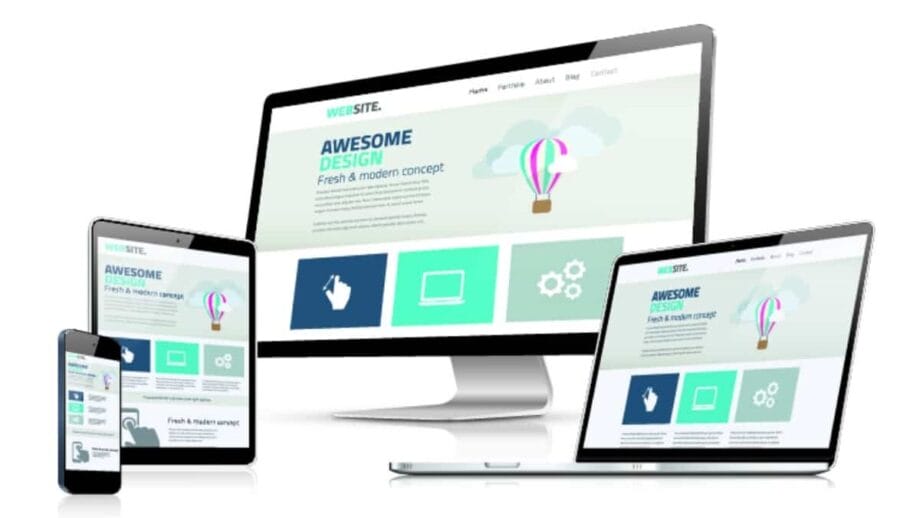Are you tired of staring at your screen, and not sure how to start building your dream website? Maybe you’re thinking about making a place online for your interior design portfolio, a landing page for your social media followers, or even just a cool spot to share photos with subscribers.
Good news – there’s an easy starting point! It’s called a “website template”. A website template is like the blueprint of a house; it gives you all the parts – rooms (or sections) and design elements – ready-made! This means you can put up your digital “house” faster than if you tried building it brick by brick.
Whether you’re setting up a portfolio website showcase or launching an online store, using these pre-designed patterns saves time and effort. Our guide will walk through choosing, customizing, and going live with your site in simple steps.
Ready to start? Let’s get creative together!
What Exactly is a Website Template?

A website template is like a pre-made web page or set of pages that you can use to build your site fast. It’s different from making a site from scratch because it comes with built-in elements like code and design. You just put in your own words, pictures, and videos. This way, you don’t have to start from zero.
Think of it as moving into a furnished house instead of an empty one – much easier, right? Templates come with things like headers (the top part), footers (the bottom part), menus for finding your way around, picture galleries, and places for people to contact you.
I once used a template for my friend’s bakery website. It saved me so much time and a headache. Instead of figuring out how to make everything look good on my own, I chose a template that already looked great.
All I did was add photos of our cakes and cookies and write about our shop. The best part was seeing it all come together without having to learn web design first!
How a Website Template Differs from a Custom Website Design?
A website template is like a ready-made suit. It’s budget-friendly and perfect for beginners who need a quick, functional site. You pick it off the shelf, and it fits well enough to look good without breaking the bank.
On the other hand, a custom website design is like having a suit made just for you. It requires working closely with a designer to get exactly what you want. This path gives unique designs and complete freedom in making choices about how your site looks.
“Custom websites allow you to stand out from the crowd with one-of-a-kind designs.”Upwork
From my own journey of putting together websites, I’ve learned that templates save lots of time and money upfront. But as projects grow or needs change, custom web builds offer more flexibility and uniqueness in branding which can really make your online presence pop.
Components of a Website Template: HTML, CSS, and JavaScript
A website template has three main parts: HTML, CSS, and JavaScript. Think of HTML as the skeleton that gives structure. It lines up everything from headings to paragraphs.
Then, CSS steps in like the outfit for our skeleton. It makes sure the website looks good with colors and styles that match your brand.
Lastly, JavaScript is like magic tricks up your sleeve. It makes websites do cool things like slide shows or pop-up messages.
I once used a website template for my own project. First, I set up the HTML to organize where my text and images would go. Next, I played around with CSS to get just the right look – picking colors that spoke “me” and adjusting font sizes until they were easy to read but still fun.
Finally, I added some JavaScript to make an image gallery more interactive so visitors could click through photos easily. This mix made my site both pretty and practical without needing to start from scratch.

Exploring Template Frameworks and Their Importance
Template frameworks – like Bootstrap or Foundation – are like the secret sauce in website templates. They help your site look good and work well without you needing to write lots of code. Think of them as a set of building blocks.
You can pick and choose which ones to use for your website’s design system. This saves you time and effort, especially if coding isn’t your thing.
I once used a template framework for my own business site. It came with built-in SEO tools that made my website easier to find on Google. Plus, keeping the look consistent across all pages was a breeze.
For businesses big or small, this is a huge win because it keeps everything looking professional without hiring a designer every time you need an update.
What are the Different Types of Website Templates?
Choosing the right type of website template is pivotal in making your site distinct. Here’s a catalog of various types you ought to be familiar with:
- Business Website Templates: Ideal for companies. Envision hotels or law firms aspiring to create a positive online impression.
- E-commerce Templates: These are intended for online product sales. Classes like retail, real estate, and fashion are included here.
- Portfolio Templates: Perfect for creatives wanting to display their efforts. Instances are graphic design portfolios in streamlined styles.
- Blogging Templates: Excellent for those focusing on creating content, such as personal blogs or news sites.
- Personal Website Templates: For disseminating your personal narrative or resume on the web.
- One-Page Templates: All information is confined to a single page. Useful for uncomplicated sites with limited content.
- Landing Page Templates: These assist in advertising particular products or services and inspire visitors to take action.
- Niche-Specific Templates: Devised for certain sectors like healthcare, education, or non-profits with customized attributes.
Each type has unique elements and styles, suitable for different needs and objectives, be it displaying creativity or conducting online product sales.
Customizing a Website Template: The Step-by-Step Guide!
Modifying a website template allows you to adjust it until it perfectly suits your needs. I’ll assist you through every stage to ensure the template fits your preferences. From modifying colors and fonts to align with your brand, to introducing new sections for an improved layout, I handle all the fundamentals.
Furthermore, I demonstrate how you can integrate your own content – be it text, imagery, or videos – to provide a distinctive touch. Rest assured, I’ll also discuss maintaining uniformity in design for a refined appearance.
I address the use of custom CSS for individuals seeking greater control over their website’s appearance. Additionally, for those interested in expanding the site’s capabilities, I provide helpful information about plugins and widgets. Keeping your site’s speed optimal is crucial, so I deliver instructions on preventing customization from causing any slowdowns.
Finally, I can’t overlook testing! It’s crucial to ensure your site operates smoothly across various devices and browsers.
Continue reading if the idea of personalizing a website template to your exact needs excites you!

Changing Colors and Fonts
Changing colors and fonts on your website is like picking the right clothes for an interview. You want to make a great first impression. Your brand has unique colors and styles that tell people who you are.
Using these in your website template makes it feel more like you. It’s easy and doesn’t cost much.
Adding your brand’s colors helps visitors know they’re in the right place. Picking fonts that are easy to read keeps them on your site longer. Tools like HTML and CSS let you change these parts without trouble.
This way, your website matches what your brand stands for – just by tweaking colors and fonts!
Adding and Removing Sections
Tailoring the layout of your website template is key to making it work for you. You can add and remove sections with ease. This way, your site fits what you need exactly. Think about a well-designed template as a base.
It makes sure visitors find their way around without trouble.
“Customization options let us change things up or down to suit our style. We took out parts we didn’t need and added spaces for new content. With tools like drag-and-drop editors, this process becomes simple and fast. Even if you’re new to this, chances are good that you’ll get the hang of it quickly after trying it out yourself!”WordPress.com
Incorporating Your Content
Filling your website with text, pictures, and videos is key. Your homepage needs to show what your business is all about in a snap. Use clear images and direct messages for this. You also want to make sure people know what to do next, like buying something or getting in touch.
I once worked on one of our client’s sites where we added a video right on the main page. It was short but told the visitors everything they needed to know about our products. We used big, easy-to-read words too.
This mix made our site stand out more than just writing lots of stuff or showing only pictures.
Understanding the Importance of Consistency in Design
Keeping your website’s look the same is key. This means using the same colors, fonts, layouts, and menus all over your site. Think of it like wearing a matching outfit; everything looks better together! I found that when I used similar styles on my own site, people stayed longer and liked it more.
Having a consistent design makes your website easy to use, too. Imagine trying to find something in a messy room versus a clean one – which is easier? Right – the clean one. That’s how users feel when they navigate a tidy and unified site.
They know where things are and how to get around without getting lost or frustrated.
Using Custom CSS for Advanced Customization
Custom CSS lets you change how your site looks in big ways. Think of it as giving your website a makeover that matches exactly what you want. You use CSS to change colors, fonts, and even the layout without touching the main code.
This means you can make your website unique without starting from scratch.
If you are in WordPress, the Simple Custom CSS and JS plugin is a tool that makes this easy. It lets you add your own styles over the template’s default look. So, if you ever want to make sure your site stands out, using custom CSS through this plugin is like having a magic wand for your website’s design.
“CSS is like makeup for your website; it lets you highlight what matters most.”Envato

Integrating Plugins and Widgets for Additional Features
Plugins and widgets add cool features to your website template. Think of these as extra tools that help your website do more things. For example, Canva Creative Studio lets you pick from different plugins to make your site look unique with your photos and text.
It’s easy too! Just one click, and bam – they’re part of your site.
I tried this on my own website once. I wanted a fancy gallery to show off my photos. So, I found a plugin for that, clicked to add it, and in no time, my pictures looked amazing online.
It was simple and didn’t slow down my site at all. Plus, checking how it worked on phones and computers made sure everyone could see my gallery just right.
Making Sure Your Customization Doesn’t Affect Performance
Making your website look great is key, but it’s also important to keep it running fast. Too many changes can slow things down. This means keeping mobile in mind so people on phones or tablets have a good time visiting your site.
Mobile optimization stops problems before they start and keeps everyone happy.
Another big point is making your website easy for everyone to use, including folks with disabilities. This way, you won’t run into speed bumps that make your site hard to enjoy. Keeping these ideas in check will help you balance looks and speed without trouble.
Testing Your Customizations on Different Devices and Browsers
Testing your website changes on various devices and web browsers is a must. Over half of internet users visit websites on their mobile phones. So, you need to make sure your site looks good and works well not just on computers but also on smartphones and tablets.
You can use tools like Google Chrome’s Developer Tools or online services that show how your site appears on different devices.
You should check your site in different web browsers too, like Firefox, Safari, and Edge. Sometimes, what looks perfect in one browser might have issues in another. By testing, you catch these problems early.
This way, visitors always get the best view of your website no matter where or how they access it.
Advantages of Website Templates over Custom Web Development
Choosing a website template can make the process of building a site much easier and faster. It’s often the best pick for those who want a professional look without spending too much time or money.
- Speed: You can get your website up and running quickly, often within an hour if you’re familiar with the basics.
- Lower Costs: Templates are more affordable than hiring a designer for a customized layout. Prices often start as low as $45.
- Professional Designs: Templates offer access to high-quality designs that might be out of reach when going custom due to budget constraints.
- Ease of Use: Most templates come with drag-and-drop editors, making it easy to create pages without knowing how to code.
- Wide Variety: There’s a massive selection of templates available, ensuring you can find one that suits your brand’s style and needs.
- Built-in Features: Templates usually include pre-designed elements like contact forms and photo galleries, saving you from having to create these from scratch.
- Consistent Updates: Template providers often update designs to keep up with web standards and technology changes, giving you peace of mind.
- Community Support: When using popular template platforms, you’ll find forums and user groups eager to help if you run into any trouble.
- SEO Benefits: Good templates are built with clean code that follows SEO best practices, helping your site rank better in search results.
- Flexibility for Growth: Many templates are designed to be scalable, meaning they’ll grow with your business without needing a complete redesign.
When starting or operating on a tight budget but still wanting a site that looks professionally made, choosing a website template is likely your best bet.

Disadvantages of Website Templates over Custom Web Development
Choosing a website template seems easy and cost-effective. Yet, it comes with its own set of challenges. Here’s a rundown:
- Limited Customization: Templates offer you just so many options to tweak things. You can change colors or fonts, but major changes? Not so much.
- Less Originality: Because these templates are available to everyone, it’s hard to stand out. Your site might end up looking like a clone of many others.
- Harder to Fit Unique Needs: If your business has very specific needs, a template might not cut it. It’s like trying to fit a square peg in a round hole.
- Slow Loading Times: Packed with features you might not even use, templates can slow down your site. A slow site annoys visitors.
- SEO Limitations: Templates aren’t always optimized for search engines right out of the box. This means you could be starting at a disadvantage when trying to rank.
- Future Scaling Issues: What works now may not work as your business grows. Templates can limit how much your site can evolve.
- Dependence on the Developer: If the person who made your template stops updating it, you’re stuck with outdated tech.
- Compatibility Problems: Sometimes, templates don’t play nice with all browsers or devices which can turn away potential customers.
From my own experience, going with a custom design was key when my standard website couldn’t meet our unique demands anymore. Think about these points if your website goals go beyond what templates offer!
Best Practices for Using a Website Template
Using a website template can make creating a site much quicker. You could get your website up in just a few days. Here’s how to do it right:
- Pick a trustworthy template provider. Some are better than others. Look for ones with good reviews and support.
- Keep your template updated. Creators often release updates that fix bugs or add features.
- Speed is key for websites. Choose templates that load fast so visitors don’t leave.
- Your site should look the same on all pages. This makes it easier for visitors to understand.
- Test your site before you show it to the world. Check if it works on mobiles, tablets, and computers.
- Listen to what people say about your site. If they find something wrong, fix it.
- Keep adding new stuff and tweaking designs. Websites that change keep people coming back.
- Content matters most! Regularly update what you write and show on the site to keep things fresh.
I learned these tips the hard way when I first started! My site looked great but took forever to load until I found a lighter template which made a big difference.
Conclusion

You just learned about website templates. They are ready-to-use designs for websites. You also know the difference between these and custom designs. Plus, you’ve seen how to pick and change a template.
Try using a template for your next site. It’s easy and fast. You don’t have to be scared to try new things with it.
Website templates work well for many but not all. Think if it fits what you need. If yes, go ahead and use one. If not, maybe look at other options.
This guide aims to make web design simpler for you. Use what you learned here as your first step in the web world!





